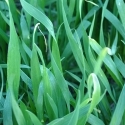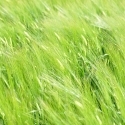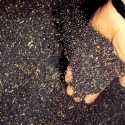13 Feb 2011
Nutrition Review - From 2010 to 2011
2010 Nutrition Review – After high yielding crops
Matthew Sparke1 and Rob Norton2
1Dodgshun Medlin Agricultural Management,
2International Plant Nutrition Institute.
Take Home Messages:
· Wheat crops remove about 3kg/t and canola about 5kg/t of Phosphorus. The right rate for P this year will need to at least replace what was removed in 2010.
· The wet 2010/early 2011 may have leached the more mobile nutrients, such as nitrogen (N), sulphur (S) and potassium deeper into the profile which suggests at-sowing rates may need to be raised for these nutrients to ensure they remain at adequate levels in the developing root zone.
· Soil profiles will contain good soil water stores this year and to use this water, adequate and balanced nutrition at sowing will be important for 2011.
· Soil testing, although far from perfect, is still the best method to assess nutrient supply to guide the right fertiliser rate. Assessing subsoil nutrient supply, particularly of N and S, will be important to get a picture of the potential subsoil nutrient supply in a wet profile and to ensure nutrients are supplied at the right time.
· Getting the right nutrient source at the right rate, right time and right place is the basis of good nutrient management. To find out more about the 4R's approach, visit http://www.ipni.net/4r.
· Decide how you will justify your inputs
Keywords: Fertilizer, Nitrogen, Sulphur, Phosphorus, Best Management Practices
What is a good nutrition program?
A good nutrition program is part of a whole agronomy package and cannot – or should not – be considered in isolation from soil type, region, the way paddocks are prepared, the crop type and cultivar, crop protection, equipment available, the yield potential and other agroclimatic issues. A good program will look to at least maintain fertility and this goes closely with soil physical and biological health. A nutrition program will look to supply what is required to meet the productivity expected and balances risk and return.
Over the past decade, due to seasonal conditions and high prices, fertilizer use in Victoria has declined by around 14% for N and 44% for P compared to the previous decade average. While this is a response to lower yields, 2011 is a time to review the strategies developed in the past decade. There is almost a whole generation that has not seen a season with high yield potential and it is a good time to review the way that seasonal opportunities can be grasped.
2010 was a different year from the past decade with rainfall providing the springboard for good to excellent yields. Although weather damage during harvest took the gloss away, yields and therefore nutrient removals were higher than we have seen for a decade. Some examples of the sorts of nutrient off-takes are given in the table below, using approximate values. However, care should be taken with these figures as there are large site differences. For example, an IPNI survey of NVT grain nutrient densities showed that wheat grain P content can vary from 2.5 to 4 kg P per t.
Table 1. Approximate nutrient removals with major grain crops. Nutrient densities are taken from Reuter, D.J., Robinson, B.J. (ed.) (1997): Plant Analysis: An Interpretation Manual. - CSIRO.
N (kg/ha) | P (kg/ha) | K (kg/ha) | S (kg/ha) | |
| Wheat (5 t/ha,12% ptn) | 105 | 15 | 18 | 6 |
| Canola (3 t/ha, 23% ptn) | 90 | 15 | 20 | 15 |
| Barley (5 t/ha, 10% ptn) | 90 | 15 | 23 | 6 |
Review of nutrient Investments made in 2010
Every grower knows how much they spend on nutrition. For examples, with Mallee wheat growers invest around $50 to $90 per hectare, at about 6 kg P ($16) Zinc ($4) and then Nitrogen ($27 to $45/ha). In the Wimmera with a higher frequency of pulses, that investment would be could be 10 kg P ($27) Zinc $4 Nitrogen ($45), while fertilizer cost per hectare could well over $120 in the higher rainfall regions. Sulphur is somewhat overlooked and less managed except in canola where Sulphate of Ammonia (SOA) is the product of choice and on sand rises, while Zinc is often used only in good seasons, but there are areas where copper and potassium could have been overlooked. Most growers would use 6 kg P/ha and 10 P kg P/ha in the Wimmera and 15 kg P/ha in SW/NE, and typically now gear N around yield expectations with rates from nil to 50 to 150 kg N/ha
P Investments - The Dahlen Incitec Pivot long term fertilizer site gives some insights for P balance – 9kg of P over the past 15 years per crop has kept Colwell P at about 25 mg/kg, and a slight positive balance in the P – i.e. input and output about equal 9 kg P = 3 t/ha wheat. But in 2010 P offtake has been two to three times the long term average offtake the implication being soil test values will decline and paddocks with big offtakes will give a larger (but still moderate) response to P this year.
Figure 1: Colwell soil P value (blue line) and phosphorus balance (bars), 1996-2007. The red line is the P soil test value at the start of the experiment.
N Investments - Interpreting N removal can also provide some guidelines to evaluate past strategies. For example, from the Longerenong Canola Challenge, the amount of N probably remaining can be estimated. Table 2 gives these data for a couple of examples, where the higher yielding crops. Interpreting these data would be meaningless unless soil test values – to give starting N and also soil Organic Carbon were available. Soil tests have some problems but they do give us information that should be considered within the whole decision making framework. Tools like Yield Prophet can assist in reviewing what the water limited potential is/was and so how N can be matched to that potential.
Table 2: Apparent Nitrogen Budgets for Longerenong Canola Challenge, 2010.
Team name | Yield (t/ha) | Soil Test | Applied N | In season mineralisation | N Removed (kg/ha) | 50%NUE | Balance |
Longy Lecturers | 2.77 | 160 | 41 | 60 | 111 | 221 | 39 |
Raging Reds | 3.47 | 160 | 40 | 60 | 139 | 278 | -18 |
BCG | 2.67 | 160 | 0 | 60 | 107 | 213 | 7 |
Other nutrient investments?
Sulphur is somewhat overlooked and less managed except in canola where SOA is the product of choice and on sand rises. For example, University of Melbourne PhD student Tauhid Khan found that SOA was a better sulphur source than gypsum for canola (Figure 2).
Grain zinc is a potential indicator of zinc response. Grain zinc levels are generally lower on the alkaline soils, and poor grain zinc can also contribute to poor establishment.
In 2010, copper deficiency was seen, probably as a result of the better growing conditions producing a bigger demand at flowering and grain fill.
Potassium responses have also been reported, in areas where we would not normally expect them such as in the Mallee. Deficiencies are seen on light soils in wet years and where hay has been cut. These are situations where there is high leaching, high demand and low potential supply.
Figure 2, Response of canola to various N and S sources in Western Victoria, 2009.
Assessing Your Investment
1. Test Strips? But what is the return on that investment? Was it a good decision to use an extra 40 kg/N on the canola crop in 2011? There are very few tools that can be used to review a fertilizer strategy, and some suggestions are to use checker board trials, test strips, or look at grain nutrient levels. If setting up test strips or omission plots, make them big enough to be used show up on a yield map so that a final assessment. During the season, they can be used as a reference to check if a response is there or if more is needed. If using optical sensors (such as “Greenseeker” ) a nitrogen-rich strip is required for calibration.
2. Grain Protein – Grain N removal is a reasonable measure of nutrient demand, and growers can use grain protein content as a post-harvest assessment of how well N supply was matched to yield potential (ie water supply). With some on-the-go protein sensors and yield maps, it should be possible to derive N removal maps for a paddock.
3. Nutrient Ratios - Other nutrient relationships can also be of use in assessing balanced nutrition, and grain N:S ratio – which is related to protein quality – is affected by relative N and S supply. Using data from the NVT, IPNI derived the graph below of N:S ratios, and imbalance exists where wheat grain S is less than 1200 mg/kg and the ratio of N:S is more than 17:1. This also gives a benchmark for matching S to N supply. There are similar interpretations for canola which has a lower critical N:S ratio (Figure 3).
Figure 3 Relationship between wheat grain N and S and potential response to S. (Randell et al, 1981, AJAR, 32, 203-212.
Looking forward to 2011
Based on what has happened during 2010, we can expect that soil profiles are full and yield potentials will be high, although be realistic about the target yield selected. Between now and sowing, summer weed control is vital to ensure that water is conserved for the crop. A nutrition program should be geared towards supporting better than average yields from the start and nitrogen and phosphorus are the big ticket items to get right before considering the others. Our advice is to concentrate fertilizer investments on the best paddocks and on the most profitable crops.
Use the 4R’s of fertilizer management – right nutrient source at the right rate, right time and right place.
Right Products – There are some new products coming into the market, and take the data presented with a healthy skepticism. Products with claims that are too good to be true are just that – not true. The bottom line is to look for a couple of years of field testing in similar environments, with yield data presented that has some measure of error or statistical analyses done and presented. Check carefully the price, and reduce price to the cost per kg of nutrient delivered to the crop.
Right Rate - Soil test values are not all the same in an area and testing a correctly collected representative soil samples is still a good way to get information about the general responsiveness to N, P and S for a paddock. Although far from perfect, topsoil (0-10 cm) P is still a good test but will not give a complete answer, as it provides a general starting point for the crop nutrition.
For N and S, use a deep soil test and look again at meeting target yields by supplementing what is on offer from the soil with fertilizers.
Right Time - The wet conditions are also likely to have leached mobile nutrients to below the root zone or even cause losses of N due to waterlogging. A direct consequence of this is that more N and S will be required early in crop growth and that less will be available in the upper parts of the root zone. After 10 years of moving away from up-front N, maybe now is the time to revisit this and put at least 30% of the target N requirement at seeding.
Right Place - For P, despite some theoretical interest in foliar applied P, it is still important to use P rates that are at least going to replace the removals. This P is the most available source to germinating seeds. Fertilizer P also provides a carrier for other materials such as trace elements and fungicides, improving logistics for delivery of these products.
If moving towards higher at-seeding rates, take care with fertilizer and seed contact, especially with urea and canola. The seeding systems used, the fertilizer applied and the crop selected will all dictate how close seed and fertilizer can be placed. Seedbed utilization indices can be of use here, and damage will be worst with wide rows, minimum disturbance, and high salt index or highly alkaline fertilizers. The strategy to adopt with at sowing fertilizer placement should be considered within the context of what machinery is available such as sowing configuration, points used and the number of boxes available.
Another confounding factor for 2011 is the big stubbles left from 2010 and this can mean more N tie-up but some disturbance can help mineralization.
Review for 2011
Now is the time to think now about how the decisions for 2011 can or will be evaluated. Life is a learning process, and unfortunately in farming we often get the punishment before the lesson. Put tests strips in place, monitor paddock fertility and grain nutrient levels in the short and long term, and keep accurate records of the complete costs of strategies used and of data used to make the 2011 decisions. Then after the 2011 harvest, critically evaluate those decisions.
Contact Details
Matt Sparke, MS@dodgshunmedlin.com.au
Rob Norton, rnorton@ipni.net




